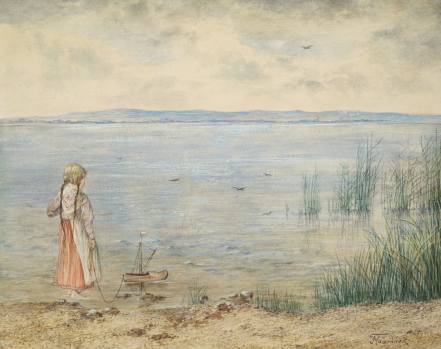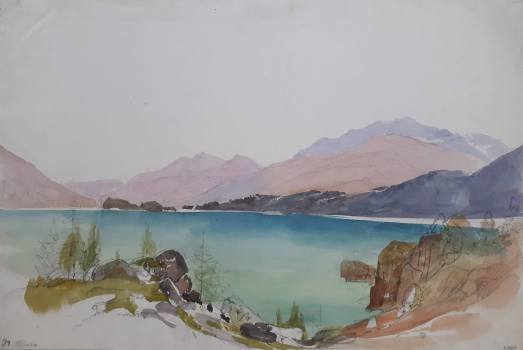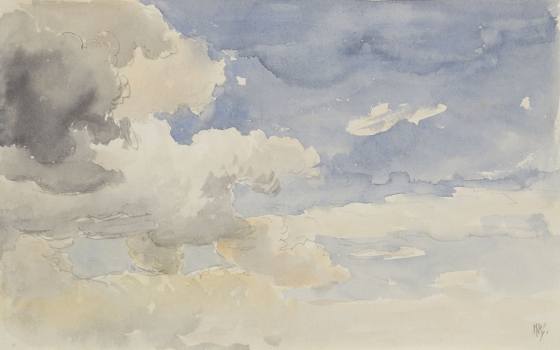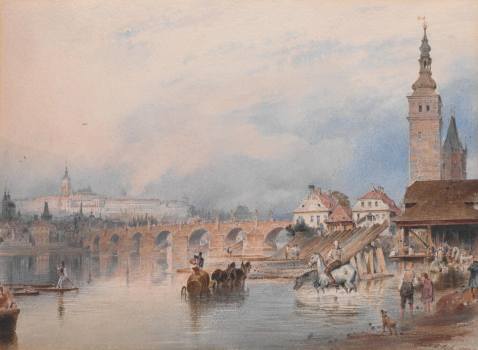Watercolour, a
technique using water-soluble paints on paper that falls somewhere in between
drawing and painting, has a long tradition in the history of fine arts. It had
its greatest growth in the 19th century when its universality influenced most
fine arts forms. Watercolour is distinguished by lightness, mastery, and virtuosity
because by definition it affords a minimum of possibilities for hesitation and
correction.
Vienna was a major centre of watercolour art in the 19th century where this technique formed a significant part of the local burgher and noble culture. The National Gallery Prague holds excellent examples of Viennese watercolour (e.g. the works of Rudolf von Alt, Thomas Ender, and Josef Kriehuber). Furthermore, extensive watercolour collections by Czech painters and paintresses are also found in the National Gallery (e.g. Antonín Mánes, Bedřich Havránek, Jan Novopacký, Amálie Mánesová, and Vincenc Morstadt). The exhibition shall not only demonstrate the artistic exchange between the two metropolises at the time they were included in a single state, but also the high quality of Czech watercolour artists as well as the impulses they brought into Central European visual culture. A large part of the artefacts is little known or will be displayed for the very first time.
The exhibition presents a comprehensive image of watercolour: besides the traditional domains (vedute, landscape, portrait, interior depictions), it shall focus on other significant topics including watercolours made by paintresses and watercolour sketches. While 19th century watercolour artists showed their mastery through suggestively depicted details, the sketches reveal a very free expression that has many common traits with modern art. The exhibition is not limited just to the Biedermeier, which is most frequently associated with watercolour, but it also covers the importance and use of watercolour up to the late 19th and early 20th centuries. Watercolour is also presented as a technique oscillating between various media: the show monitors its relation towards graphic art, painting, architecture, and photography as well. Furthermore, the exhibition provides an opportunity to understand 19th century art as a rich visual world whose multiple components were vividly interconnected and affected one another.
Exhibition concept: Petr Šámal, Department of Art History, Faculty of Arts, Charles University
Exhibition curator: Petra Kolářová, NGP
Trade Fair Palace – 1st floor
Vienna was a major centre of watercolour art in the 19th century where this technique formed a significant part of the local burgher and noble culture. The National Gallery Prague holds excellent examples of Viennese watercolour (e.g. the works of Rudolf von Alt, Thomas Ender, and Josef Kriehuber). Furthermore, extensive watercolour collections by Czech painters and paintresses are also found in the National Gallery (e.g. Antonín Mánes, Bedřich Havránek, Jan Novopacký, Amálie Mánesová, and Vincenc Morstadt). The exhibition shall not only demonstrate the artistic exchange between the two metropolises at the time they were included in a single state, but also the high quality of Czech watercolour artists as well as the impulses they brought into Central European visual culture. A large part of the artefacts is little known or will be displayed for the very first time.
The exhibition presents a comprehensive image of watercolour: besides the traditional domains (vedute, landscape, portrait, interior depictions), it shall focus on other significant topics including watercolours made by paintresses and watercolour sketches. While 19th century watercolour artists showed their mastery through suggestively depicted details, the sketches reveal a very free expression that has many common traits with modern art. The exhibition is not limited just to the Biedermeier, which is most frequently associated with watercolour, but it also covers the importance and use of watercolour up to the late 19th and early 20th centuries. Watercolour is also presented as a technique oscillating between various media: the show monitors its relation towards graphic art, painting, architecture, and photography as well. Furthermore, the exhibition provides an opportunity to understand 19th century art as a rich visual world whose multiple components were vividly interconnected and affected one another.
Exhibition concept: Petr Šámal, Department of Art History, Faculty of Arts, Charles University
Exhibition curator: Petra Kolářová, NGP
Trade Fair Palace – 1st floor
1—1 / 6













